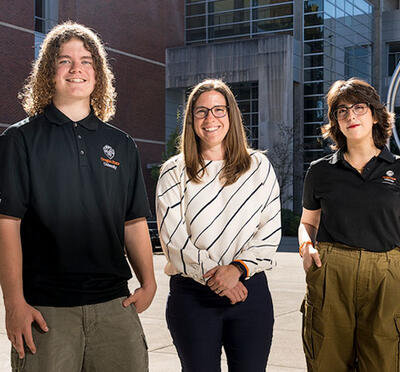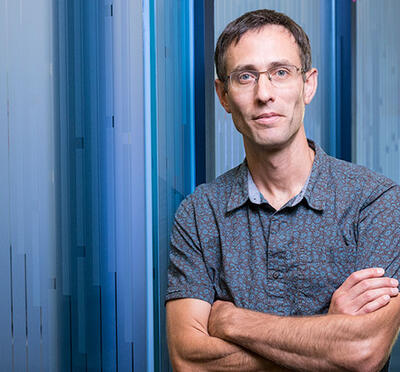The National Science Foundation has awarded four recent graduates from Oregon State University’s College of Engineering the 2024 NSF Graduate Research Fellowship. This five-year fellowship provides three years of financial support inclusive of an annual stipend of $37,000 and a $16,000 allowance for tuition and fees.
Fellows are recognized as outstanding students who demonstrate the potential to become knowledge experts in their fields, contributing significantly to research, teaching, and innovation throughout their careers.
The NSF Graduate Research Fellowship is the oldest fellowship of its kind in the U.S., funding over 70,000 students since its inception in 1952.

Phillip Hernandez, B.S. bioengineering ’22, is pursuing a Ph.D. in bioengineering at the University of Oregon’s Phil and Penny Knight Campus for Accelerating Scientific Impact under the advisership of Danielle Benoit, the Lorry Lokey Chair of the Department of Bioengineering, and Robert Guldberg, vice president and Robert and Leona DeArmond Executive Director.
Hernandez is looking to develop an advanced therapeutic composed of RNA-loaded polymeric nanoparticles for attenuating effects of osteoarthritis. This will include in vitro drug screening and in vivo pre-clinical testing, Hernandez said.
“Osteoarthritis is a degenerative joint disease that affects over 500 million people worldwide,” Hernandez said. “Yet, there are no FDA-approved disease-modifying osteoarthritis drugs currently on the market.”

Grant McConachie, B.S. bioengineering ’20, is a Ph.D. student at Boston University researching the neurobiology of mosquito olfactory systems to develop novel chemicals aversive to the insects.
McConachie is creating computational models related to Aedes egypti, the mosquito species responsible for the transmission of dangerous viruses like dengue, yellow fever, chikungunya, and Zika.
He’s predominantly looking at two types of machine learning models: graph neural networks to model odorous chemicals and their interactions, and connectome-constrained models of neurons related to mosquito olfactory systems.
“Mosquitoes cause a lot of harm to humans,” he said. “With recent advances in machine learning methods, and an increased understanding of the mosquito olfactory system, I am trying to combine these two domains to ease the burden of mosquito-borne diseases.”

Dominique Lee Gramm, B.S. bioengineering ’23, is a doctoral candidate in the University of Notre Dame’s bioengineering program. Gramm works with Donny Hanjaya-Putra, assistant professor of aerospace and mechanical engineering, analyzing the functionality of blood vessel networks in stem cell organoids.
“I decided I wanted to learn the intricacies of the brain, how we can model it accurately using 3D cell cultures, and use this information for neurodevelopmental studies,” she said.
Before coming to Oregon State, Gramm served in the Navy for five years and was awarded the Military Outstanding Volunteer Service Medal.
This summer will bring her first child. “Before I even think of my plans after my Ph.D., I’ll have to figure out how to be a mom first,” she said. As a scholar and as a future mother, she hopes her research will benefit society as a whole. For now, she’s taking life “one step at a time.”

Katie Trese, B.S. bioengineering ’21, is investigating nanoparticle engineering at the University of Colorado Boulder with advisor Wyatt Shields, assistant professor of chemical and biological engineering.
She specifically investigates nanoparticle engineering, the ability of sound waves to purify cells, and the effect of nanoparticles on immune cell behavior.
Because some immune cell types are particularly good at migrating to sites of inflammation, her goal is to harness this capability to bring drug-loaded nanoparticles directly to diseased tissue. She is also looking into how to purify these cells with sound waves.
“My hope is that the work done in this project will improve accessibility and patient outcomes for cell-based immunotherapies across a variety of treatment scenarios,” Trese said.
After completing her Ph.D., Trese hopes to lead a team conducting immunoengineering research for a company or national lab. Besides research she’s developed an interest in spending time outdoors, as well as spinning pottery.

Bridget Price, B.S. chemical engineering and resource management ’23, was among last year’s NSF Graduate Research Fellowship awardees and will soon use this funding to attend the University of Wisconsin as a doctoral student in chemical engineering.
As a Fulbright Scholar, Price is living in the Netherlands, where she is researching methods for enhancing nutrient removal from greenhouse wastewater at Wageningen University.
Her project involves creating a sustainable microalgae cultivation technique by selecting microalgae and nitrogen-fixing bacteria pairs for co-cultures and quantifying beneficial species interactions. The results should point toward methods that reduce the amount of nutrients required for microalgae biofuel production, she said.
“My immediate future obviously looks like me doing my Ph.D.,” Price said. “But in the distant future, I hope to continue participating in the microalgae cultivation field — either in industry or academia — and I would like to see if I can once again take my research abroad.”



